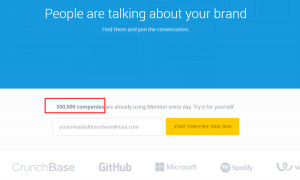Targeting high-impact keywords is critical to success every time you prepare an article in your content marketing system. The Google Keyword Planner tool is a tremendous resource for identifying keywords with a healthy mix of search potential and limited competition.

Keywords with moderate traffic, but a definite upward trend offers a real target.
Here are seven insider tips to help you get the most benefit while using the Google Keyword Planner: 1) Consider Search Volume Trends
1) Consider Search Volume Trends
Some people get too caught up looking just at current statistics on searches for a set of keywords. Pay close attention to volume trends as well. From the Keyword Planner home page, the second option is, “Get search volume data and trends.”
After you enter one or more phrases and other filters, enter your search. What you see next as a graph depicting estimated searches for the last several months. The advantage of looking at search trends is that you could potentially target keywords with rapidly growing demand and limited competition. Also, focusing content on concepts and terms with increasing audience interest rather than declining searches means your article’s value may hold weight for longer.
Google adwords keyword planner tool will show search trends.
2) Be Cautious with Number Assumptions
Programs like Google’s Keyword Planner are typically driven by estimating tools rather than exact scientific calculations. In a recent article, software giant Moz explained how Google’s rounding of estimate searches is driven by number buckets. For instance, if the phrase “Boston patriot” produces 1,500 monthly searches, the actual number could be several hundred more or less. If this phrase is searched enough to far exceed the 1,500 threshold, it would likely bump to the next “search bucket” number, such as 2,200.
At small volume levels, the rounding procedure has relatively limited impact on your ability to pick keywords. When you get into estimates of hundreds of thousands of searches, estimates could be off by tens or hundreds of thousands, according to Moz.
3) Double Check for Keyword Combinations
Google also combines certain keywords when reporting estimates through its Keyword Planner. The problem, according to Moz, is that the way certain phrases are treated in the planner is often different from how they are actually treated in an organic search.
As an example, assume the planner shows search volume for term “X” is exactly the same as search volume for somewhat related term “Y” in the planner tool. These equal projections are likely based on the planner combining related searches in communicating these amounts. In reality, if organic Google results produce a much higher volume of searches for “Y”, a writer focusing on term “X” would miss out on traffic opportunities.

Identify potential keywords to include in your organic or paid search campaign.
4) Add Keywords to Your Campaign Plan
The purpose of the planner tool is to identify potential keywords to include your organic or paid search campaign. Search Engine Journal recently pointed out the benefit of saving preferred keywords to your “plan” rather than downloading them to a .CSV file. With this approach, you keep all phrases in front of you until complete. After you collect a list that you want to target, you can then save them together to a spreadsheet.
5) Balance Search Volume with Competition
Like other types of marketing, content marketing is most effective when driven by a well-defined strategy. Large publishers with strong domain authority can afford to compete for traffic by targeting high search volume phrases. Even in a competitive market, a Google-friendly website will do well.
However, many small businesses and niche publishers have to focus on finding the right balance between desirable search traffic and modest competition. For instance, a keyword with an estimated 3,500 searches, but “Low” competition, is likely more appealing than a phrase with 9,000 searches and “High” competition. Simply put, you are better off earning 500 of 3,500 possible searches than none of the 9,000 possible searches with a competitive keyword. Long-tail keywords, or phrases with several words, are popular for trying to hone in on a more specific audience.
On its support page, Google also points out that more specific keyword phrases are better for targeting narrow markets, whereas broader phrases offer potential access to a larger marketplace.
6) Verify with Other Planner Tools
The Keyword Planner tool attempts to find the best phrase match when making its recommendations on search estimates. However, Moz noted that the returned results often included phrases completely off-base from the target words you originally entered. Therefore, it is advisable to confirm the accuracy of estimates using other tools before investing a lot of time in developing content or money in paid search campaigns.
One of the other prominent tools that you can use to access volume estimates is ClickStre.am. If you get similar results with multiple tools, the likelihood of having enough intelligence when you invest in search marketing is higher. Keep digging if you get completely mismatched results.
7) Look for Themes or Clusters
After you enter a search phrase, the Keyword Planner returns estimates for that keyword, as well as other related terms. As you look for these related terms, look for opportunities to incorporate correlated phrases into your article or blog post. WordStream recently pointed out that integrating closely related phrases in your content, and in your subheadings particularly, makes it clear to Google that your content has a theme.
Google has given greater priority in search results to synonymous keywords. Applying alternative phrases from your primary target helps you avoid keyword stuffing as well.
Summary
Using these insider tips with the Google Keyword Planner tool allows you to develop a strong content marketing strategy. These tips are valuable whether your focus is organic search engine optimization, paid search marketing or content development. Even without SEO, monitoring search trends offers insights into what types of content people are aggressively searching for right now.
Digital & Social Articles on Business 2 Community
(33)







